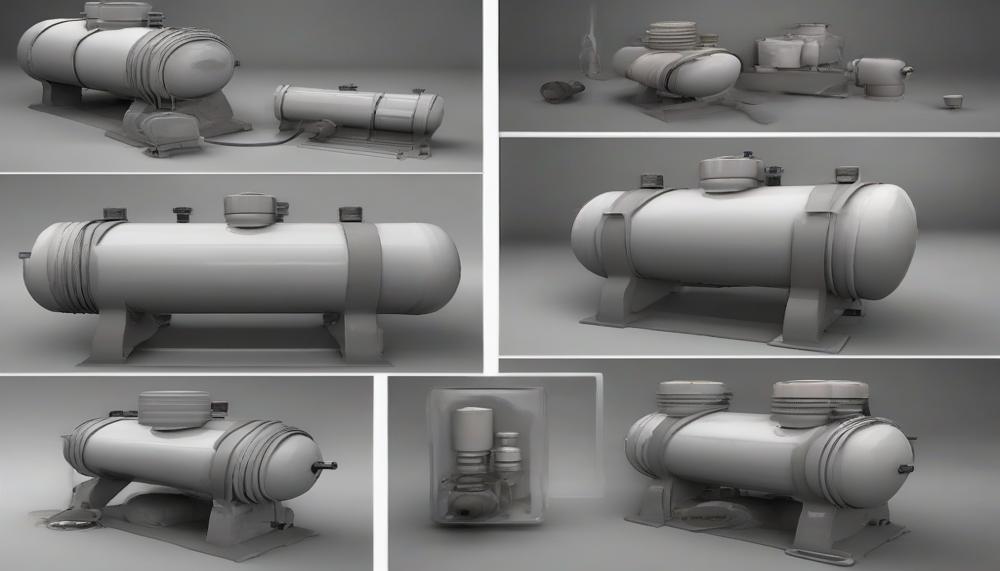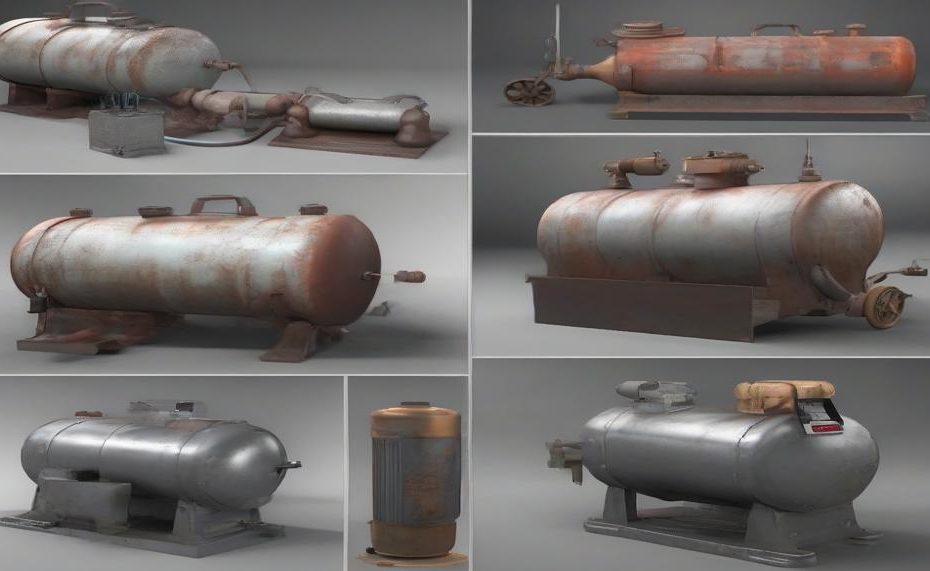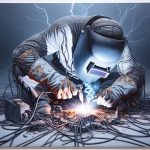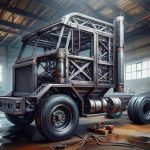Are you in search of a new air compressor to add to your arsenal of tools? Or perhaps you’re a DIY enthusiast seeking to elevate your workshop game.
Regardless, having a thorough understanding of the welding process for air compressor tanks is crucial. It helps you make an informed decision.
- Welding plays a critical role in the production of air compressor tanks.
- It ensures robustness, longevity, and impeccable performance without any leaks.
- Various welding methods are utilized based on the type of tank and its intended purpose.
- The quality of welding can significantly impact the overall effectiveness and lifespan of an air compressor.
- Don’t fret if you’re not well-versed in welding terminology – we’ll simplify it for you in this blog post.
Whether you’re an experienced welder or simply curious about the process, come along. We will delve into the realm of welding air compressor tanks. We’ll cover everything from materials and techniques.
We’ll also discuss common errors and how to avoid them.
So grab your protective gear and let’s begin our journey.

Can You Really Weld an Air Compressor Tank?
Welding is a highly effective way to fix damaged air compressor tanks, but it must be done correctly and with the right tools.
You can repair leaks and strengthen any damaged areas of the tank using welding techniques. This makes it safer and extends its lifespan.
However, there are some important factors to consider before embarking on such repairs.
</tr</tr</trSome important considerations when welding an air compressor tank include using the appropriate type of welding setup and technique for the specific type of tank and damage, ensuring proper metal finishing for added durability, and taking necessary safety precautions.It is also recommended to have the tank inspected by a professional before attempting any repairs to determine the best course of action.How Do Air Compressor Tanks Get Damaged?Air compressor tanks are prone to damage due to various factors such as corrosion, overpressure, incorrect installation, regular use, and external impacts. These elements can weaken the tank’s structure, causing leaks or even complete failure.By carrying out regular maintenance and using the tank correctly, you can prevent damage and enhance its durability.
- One of the most common causes of air compressor tank damage is corrosion. This is a natural process that occurs when metal is exposed to oxygen and moisture. Over time, corrosion can weaken the tank’s walls and make it more susceptible to leaks. To prevent this, you should regularly inspect the tank for any signs of rust or damage and take immediate action if necessary.
- Another factor that can damage air compressor tanks is overpressure. When the tank is subjected to excessive pressure, it can cause the walls to bulge or even rupture. This can be dangerous and result in serious injury or property damage. To avoid this, always follow the recommended operating pressure for your specific tank and never exceed it.
- Improper installation can also lead to air compressor tank damage. If the tank is not installed correctly, it can put unnecessary stress on its structure, causing cracks or leaks. It is essential to have a professional install your tank to ensure it is done safely and correctly.
- Regular wear and tear from frequent use can also contribute to air compressor tank damage. As with any equipment, constant use can cause parts to wear out and become less effective over time. To avoid this, make sure to follow the manufacturer’s recommended maintenance schedule and replace any worn-out parts promptly.
- Finally, impact damage from external sources can also harm air compressor tanks. This can occur from accidental drops or collisions with other objects. It is crucial to handle your tank with care and protect it from potential hazards.
What Are The Different Techniques of Welding an Air Compressor Tank?When it comes to welding an air compressor tank, there are various techniques available, each with its own set of benefits and considerations. The most commonly used methods include TIG (Tungsten Inert Gas) welding, MIG (Metal Inert Gas) welding, and plasma cutting.TIG welding is a precise and versatile technique that utilizes a non-consumable tungsten electrode to create a weld pool. This method is ideal for thin materials and produces a clean and high-quality weld. However, it can be time-consuming and requires a skilled operator.On the other hand, MIG welding, also known as Gas Metal Arc Welding (GMAW), utilizes a consumable wire electrode and a shielding gas to create the weld. It is faster than TIG welding and can handle thicker materials. While the resulting weld may not be as clean as TIG welding, it is still robust and long-lasting.For thicker materials, plasma cutting is another viable option for welding an air compressor tank. It involves using an electric arc to ionize gas and create plasma, which effectively cuts through the metal. Though faster than other methods, it may produce less precise results.The strength and durability of the weld ultimately depend on the operator’s skill level and the tank’s condition. Proper surface preparation, including thorough cleaning and degreasing, is vital before welding to ensure optimal adhesion. Furthermore, regular maintenance of the finished weld is necessary to extend the lifespan of the air compressor tank.Therefore, it is recommended to hire a skilled and qualified welder for safe and secure repairs or installations of an air compressor tank.What Are The Types of Metal Finishes in Air Compressor Tanks?The welding capabilities of air compressor tanks can be affected by various types of metal finishes. These finishes include oxidized surfaces, high pressure, leaks from cracks or holes, leaks from fittings or valves, and faulty tank structure.Oxidized surfaces can cause issues with adhesion, strength, and sealing of the weld. To ensure a strong bond, it is essential to properly clean and prepare the surface before welding.In an air compressor tank, high pressure can lead to dangerous explosions or fires if not released before welding. Therefore, it is crucial to release the pressure before beginning any welding work.Leaks from cracks or holes in the tank can be caused by corrosion, impact damage, or simply old age. These should be promptly repaired to prevent further damage to the tank.Leaks from fittings or valves are also possible and should be tightened before testing the tank’s pressure again. If the leaks persist, it may be necessary to replace these components.Additionally, faulty tank structure can greatly affect welding capabilities. In some cases, it may be more efficient to replace the entire tank rather than attempting to repair it.Aside from these finishes, selecting the appropriate welding technique for air compressor tanks is crucial. Techniques such as keyhole welding, MIG welding, plasma welding, and GTAW (TIG) welding all have different effects on different types of metal finishes used on air compressor tanks. For example, primed steel coated with paint or powder coating can provide added durability.When it comes to welding an air compressor tank, safety precautions must always be taken. This includes wearing proper gear and ensuring that the area is free of any flammable materials. It is also important to have a professional inspect any potential damage and determine if repairs or replacement are needed.In conclusion, having a thorough understanding of the various types of metal finishes used in air compressor tanks and their effects on welding capabilities is crucial for ensuring a safe and successful welding process.How Safe is Welding an Air Compressor Tank?When embarking on the welding process for an air compressor tank, safety should always be the top priority. As the tank is under high pressure, even the slightest mistake during welding can result in serious accidents.Therefore, it is crucial to take the following safety precautions to ensure a safe and successful welding process:
- Seek professional guidance: Before attempting to weld an air compressor tank, it is essential to consult with a skilled and knowledgeable welder. They can provide valuable insights and advice on proper techniques and safety measures for welding the specific type of tank.
- Empty and clean the tank: Before starting the welding process, make sure the tank is completely empty and free of any residue or contaminants. This step is crucial to avoid explosions during welding.
- Work in a well-ventilated area: Welding produces harmful fumes and gases, so it is important to work in a well-ventilated area. If possible, use a ventilation system or open windows and doors to allow fresh air circulation.
- Protect nearby combustibles: Sparks and heat from welding can easily start fires, so it is crucial to cover any nearby combustible materials with fire-resistant blankets or sheets.
- Wear proper personal protective equipment (PPE): Always wear appropriate personal protective equipment such as welding gloves, face shield, welding helmet, and safety glasses. These items will protect you from sparks, heat, and harmful fumes.
- Select the right welding technique: The type of welding process used for an air compressor tank depends on its material. For example, MIG (Metal Inert Gas) or TIG (Tungsten Inert Gas) are commonly used for steel or aluminum tanks.
- Thoroughly clean and prepare the tank surface: Before welding, ensure that the tank surface is thoroughly cleaned and prepared to avoid contamination or damage to welds. Any rust or debris should be removed using appropriate tools.
- Follow safety standards and regulations: Welding air compressor tanks requires strict adherence to safety standards and regulations. Be sure to follow all guidelines and procedures to ensure a safe welding process.
- Hire a skilled welder: If you are not experienced in welding, it is best to hire a qualified and skilled welder for the job. They will have the necessary knowledge and expertise to ensure a safe and successful welding process.
- Conduct rigorous testing: After welding, it is crucial to conduct thorough testing, including visual inspection and pressure testing, to ensure the welds are strong and durable. This step is essential for the safety and functionality of the air compressor tank.
When it comes to welding an air compressor tank, there is no room for error. Just like Grant Cardone says, “Success is your duty, obligation, and responsibility.” Therefore, it is important to take all necessary safety precautions to ensure a successful welding process. Remember, always prioritize safety over speed or convenience.What to Consider Before Starting to Weld an Air Compressor Tank?Before beginning to weld an air compressor tank, there are important aspects to consider. These include the type, size, and thickness of the tank, as well as the proper welding method, safety precautions, and maintenance.It is also important to select the appropriate material for the job, as it must be compatible with the contents and purpose of the air compressor tank. In addition, before attempting any repairs on an air compressor tank, it is necessary to assess its condition and seek guidance from a professional welder.How to Weld an Air Compressor Tank?Welding an air compressor tank may seem like a daunting task, but with the right knowledge and precautions, it can be done safely and effectively.This guide will walk you through the steps involved in welding an air compressor tank, from understanding its complexity to maintaining it for long-term durability.Understanding the Complexity of Welding an Air Compressor TankThere are several factors to consider when welding an air compressor tank, such as the type, size, and thickness. Different types of tanks may require different welding techniques, and the size and thickness can affect the strength of the weld.It is important to thoroughly understand these factors before starting the welding process.Choosing the Right Material for Your Air Compressor TankAir compressor tanks are typically made from weldable steel. When choosing a material, it is crucial to consider its compatibility with the contents and usage of the tank to prevent corrosion and other issues.Regular maintenance of the tank is also important to prevent damage and ensure efficient operation.Selecting a Suitable Welding Method for Strong and Durable WeldsDepending on the type and thickness of your tank, different welding methods may be more suitable for achieving strong and durable welds.TIG or MIG are commonly used methods for welding air compressor tanks.Taking Necessary Safety PrecautionsWelding can be dangerous, so it is important to take necessary safety precautions such as wearing protective gear and evaluating the extent of damage before attempting repairs.This includes wearing gloves, helmets, and safety glasses, as well as evaluating the extent of damage before attempting any repairs.Properly Maintaining Your Air Compressor TankRegularly inspecting and maintaining your air compressor tank can help identify potential issues before they become major problems. This can help extend the lifespan of the tank and avoid costly replacements.If Replacement is NecessaryIn some cases, replacement of the tank may be necessary. It is important to choose the appropriate size and type of tank for your specific needs and usage requirements.Thoroughly Cleaning the Surface of the TankBefore beginning the welding process, it is crucial to clean any dirt, debris, or rust from the surface of the tank. This will ensure a strong and clean weld.Applying Appropriate FinishesAfter welding, it is recommended to apply finishes such as powder coating or passivation to protect against corrosion and rusting. This will add long-term durability to your air compressor tank.Proper Techniques for Repairing HolesDifferent thicknesses of tanks may require different techniques for repairing holes. It is important to consult with a professional if unsure of the proper technique to use.Safety Precautions During WeldingIt is always best to consult with a professional welder or experienced enthusiast for advice on materials, sizes, and techniques before attempting any repairs.Also Read: Which Tungsten Is Best For Stainless Steel?ConclusionThe welding process is a critical step. It ensures the strength, durability, and flawless performance of air compressor tanks. Depending on the type of tank and its purpose, various welding methods are used. The quality of welding can greatly affect the overall effectiveness and lifespan of an air compressor. Therefore, it is crucial to thoroughly understand the welding process before deciding to buy or fix an air compressor tank.In this article, we have covered everything from materials and techniques to common errors and how to avoid them. We have also discussed important factors to consider before beginning the welding process. These factors include the type, size, thickness, and proper maintenance of the tank. Furthermore, we have emphasized the utmost importance of safety precautions when working with high-pressure tanks.Whether you’re a professional welder or a DIY enthusiast looking to elevate your workshop skills, it’s essential to have a solid understanding of welding techniques for air compressor tanks.By following these guidelines and taking necessary precautions, you can ensure a safe and successful welding process. This will extend the lifespan of your air compressor tank.
| Pros | Cons | Considerations |
| – Can effectively fix leaks and damage | – Requires proper tools and knowledge of techniques | – Safety precautions must be taken seriously |
| – Extends the lifespan of the tank | – May not be suitable for all types of tanks or damage | – Professional inspection may be necessary before repairs |
| – Cost-effective compared to replacing the tank | – Proper metal finishing is crucial for durability | |
| – Regular inspections and maintenance can help prevent damage | ||
| – Structural repairs on tanks should not be done using JB Weld | ||
| – Rust removal is also important for tank maintenance | ||
| Factor | Description | |
| Type of Tank | The selection of an air compressor tank will dictate the appropriate welding techniques and materials to use. | |
| Size of Tank | The size of the tank will impact how much pressure it can handle and may require additional reinforcement during welding. | |
| Thickness of Tank Walls | Evaluating the thickness of the tank walls is crucial prior to welding to ensure they can withstand high pressures. | |
| Welding Method | The type of welding method chosen will depend on the type and thickness of the tank. TIG or MIG welding are commonly used for air compressor tanks. | |
| Safety Precautions | Proper ventilation and protective gear are essential when welding an air compressor tank to prevent accidents and exposure to fumes. | |
| Maintenance | To extend the lifespan of an air compressor tank and avoid expensive repairs or replacements, regular maintenance is critical. |





